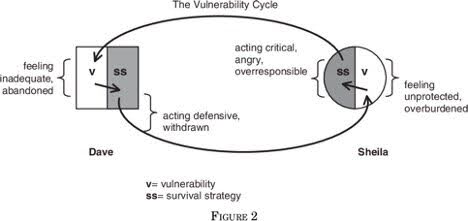Folks sometimes come into relationship therapy feeling stuck. They keep getting into arguments, they don’t feel understood or heard, or maybe they don’t feel themselves in particular moments in their relationship. As a systemic therapist, I understand relational concerns as challenges in the dynamic between people. I am trained to look for and map these sequences so that I can support people in stepping out of their cycles and trying something new. One of my favorite ways to map out cycles between two people is called the Vulnerability Cycle, developed by Michele Sheinkman and Mona Dekoven Fishbane. Cycles such as vulnerability cycles come to resemble a dance, with steps that predictably happen one after the other. I have learned that mapping these cycles is not just helpful in my own conceptualization of what is going on, but that clients also benefit from learning about their vulnerability cycle. I have had individuals take them home and discuss them with their partners, and couples who have put them on their fridges as reminders of their patterns.
Beyond that, I have seen how awareness of one’s vulnerability cycle can facilitate change through an increased ability to jump out of the cycle and look at it together. Rather than doing the cycle itself and being consumed by it, couples were increasingly able to look at each other and say “hey, we’re doing that thing again,” and redirect their energy elsewhere. The act of agreeing that you’re doing the cycle, while in the middle of it, can itself be disarming, though is certainly not easy. Some folks find the information and the predictability grounding, with the sentiment that it’s not that there are a slew of problems, but that they are really just struggling with a “how.” In order to interrupt a pattern, you first have to know you’re doing it, so that someone can try a new step, and the couple can ultimately make a new dance.
Below is what a vulnerability cycle looks like, with a example couple, Dave and Sheila, (Scheinkman and Fishbane, 2004, page 292, Figure 2). As with any cycle, there is no single starting place. As such, one way to read this is as follows: Dave, depicted by the square on the left, is acting defensive and withdrawn, which are his survival strategies (the dark part of the square). His defensiveness and withdrawal, leads Sheila to feel unprotected and overburdened, her vulnerabilities. This internal process for Sheila leads her to act critical, angry, and over responsible (survival strategies), leading to an activation of Dave’s vulnerabilities of feeling inadequate and abandoned. And so the cycle continues. Vulnerabilities and survival strategies are unique to the person, as is what they bring about in the other.
Defining Terms and Common Patterns
Vulnerabilities are personal pains that happen in our internal worlds. They typically originate from some emotional wound, challenge or role from earlier on in life. It can take quite a bit of time to understand the origins of vulnerabilities, which can be a frustrating experience. Even if we discover our vulnerabilities come from a long time ago and can’t be healed in their original context, there is still space to heal them in the couple’s context with the care and attunement of one’s partner. It is this work that can facilitate an increased pause between one’s own vulnerabilities and survival strategies.
Survival strategies are the behaviors and external signals that we developed to protect ourselves at moments of vulnerability. Often these protective strategies were highly effective at the time they were developed. A young child experiencing abuse, may learn to placate the adults, or hide from threats. The oldest sibling may learn to get loud in order to advocate that themself and their siblings get their needs met. Whether the threats are real or imagined, they are still experienced and thus we develop ways of coping and seeking security and comfort.
There are a few common types of cycles which are characterized by the survival strategies. One common pattern is known by therapists as pursue-withdraw; one partner pursues the other with a challenge or concern and the other withdraws into themself, their hobbies, or their phone. Pursue-pursue, and withdraw-withdraw are also seen. There are of course complications to these patterns as well, for example, the burnt out pursuer may look on the surface like a withdrawer, and vice versa.
To identify your own vulnerability cycle, consider the following activity:
Think of something your significant other, friend, sibling, parent, or child did that made you feel something visceral. Go back to that moment and try to access what you were feeling. Where do you notice it in your body? Is this feeling familiar or something new? See if you can identify the first time you felt this way. How would you describe what it is that you were feeling? These may be some of your vulnerabilities. Keeping those vulnerabilities in your mind, run through the event again. This person’s external signals hit some of those vulnerabilities. What do you think an outside observer would notice about you in that moment? How were you in response? Connect with this person (if age appropriate) and see if they can identify what your external signals brought about for them. Jot down what you came up with and see if it seems to describe how you engage with one another in other types of arguments. Continue to revisit this until it feels like you’ve come to a good fit for your own pattern.
See if you can pay attention to your internal signals when you start to get into one of these arguments, or otherwise feel disconnected. Test and see if there is space to try something different or to take a new step in the dance, or step outside of it with your partner.
If you are interested in learning more about marriage counseling in Philadelphia, contact our team today!





